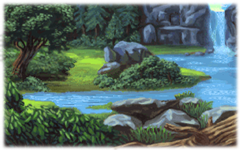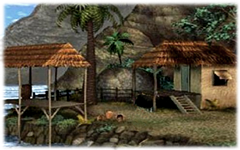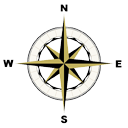This article or section contains information from Lori and Corey Cole’s (Transolar Games) extended Hero Universe (Hero-U Canon and/or Apocrypha).
Details may include information from Hero-U and Summer Daze, other published sources (pre-QFG & later) including books, comics, documentation and DnD supplements. It may also contain information from unreleased novels (and games), notes, concept materials, and developmental ideas from Quest for Glory outside of the original series canon.
The Tetralogy concept is a developmental idea by the Coles in which the games would have originally represented the four elements, the four seasons, four directions, the four eras in the life of a hero (from adolescence to maturity). As such it may have had both symbolic and literal aspects thar overlap developmental ideas such as the Year concept and the Multiyear concept.
Background[]
It has been stated by the creators Lori and Corey Cole that the series was always supposed to only consist of four games. The locations visited within the tetralogy were to correspond with various other symbolic cycles of four, such as the 4 classical elements, the 4 seasons, and the 4 cardinal directions. These icons are not merely design inspirations for each game, however - they are also allegory for the Hero's own personal maturation and the honing of skills, a cyclical representation of his own "coming-of-age" story. According to Lori:
- We also conceived of the series as well as the first game. We wanted to create the series that was more like a book trilogy than separate games, and took a Hero from his first days as a beginning fighter to his crown of rulership by right of Goodness. So we also mapped out the series as a four game quadrology.
Some aspects of the concept can support a single Year concept timeline or the Multiyear concept either of its take symbolically or literally; such as idea that hero grew from being an adolescent into young man, into an adult, and finally a mature adventurer over the course of the stories could imply longer period of time passing (much in same way KQ reboot uses theme of seasons but show Graham age throughout his lifetime).[1]
This is best explained in several statements given by the Coles in the past:
Seasoning a Swashbuckler[]
“The concept of seasons in the games represents the maturation of the Hero as he moves from story to story. It's a critical component in a series that - from the very beginning - was designed to be a defined quartet of stories, representing an overall saga with a distinct beginning, middle, and end.
“One of the unifying themes,” explained Corey, “is the growth of your character, going from being an adolescent Hero in the first game to being a young man in the second. You're strong and confident...”“The third game,” continued Lory, “was to show you as a master of your profession, with the fourth depicting you at the mature peek of your powers.”
In the first episode, the player is a new graduate of the Famous Adventurer's Correspondence School, ready to venture out into the springtime of his career and build a rep. It's a light-hearted, exhilarating journey into the unknown that can be replayed three times with three distinct outlooks at puzzle-solving.
In the second chapter - Trial by Fire - the Hero enters the summer of his experience, facing more difficult challenges with more highly-developed skills. While the episode is more serious and dangerous than its predecessor, it retains the enchanting mixture of fantasy, challenge, and humor that made the first game a hit with so many fans.
Of all the reasons Lori and Corey found for creating a bridge between Trial by Fire and Shadows of Darkness, the most compelling was the feeling the designers had that the Hero character simply hadn't matured enough to face the very grim challenges awaiting him in Transylvania.
“Somewhere between finishing Trial by Fire and cranking up the design process for Shadows of Darkness, the husband-and-wife team realized a fifth chapter would have to be added to bridge the games. That chapter became Wages of War...If all the reasons Lori and Corey found for creating a bridge between Trial by Fire and Shadows of Darkenss. the most compelling was the feeling that the Hero character simply hadn't matured enough to face the very grim challenges awaiting him... “Wages of War is the bridge,” she continues. “You start with people you know to help you along in the beginning. But when push comes to shove, you're the one who's on his own, who has to solve the ultimate mystery.” As you go along, just when you think you're all alone, your allies come back to you, but you have to face the final challenge by yourself.” -Lori & Corey Cole
The History of Quest For Glory[]
Lori: Quest tor Glory was conceived as a series. I wanted to take the character from novice adventurer and "wannabe" hero to seasoned adventurer and true Hero of the World. It's not something that happens overnight. The world of Q.F.G. is a fantasy analogy of our own world. There is more to do and see than we could ever fit into a single game. The series was originally supposed to be four games, but it evolved into five as we worked on it.
Corey: You see, we had this all worked out - four games representing the four seasons and the four classical elements (Earth, Fire, Air, and Water). But our planned Gothic horror setting for game 3 seemed too extreme for the character after "Trial By Fire", so we slipped in an additional game to fill in the gap. In "The Wages of War", the Hero will visit Rakeesh and Uhura's homeland, learn more about honor and friendship, and prepare for the challenge of "Shadows of Darkness". " Wages of War" fits naturally into the overall series storyline. It advances the player's character's development into an archetypal Hero.
Blackwine: My question is about the world of Gloriana in general. I knew each game was supposed to correspond to a place on a compass (like North, South, East, West) and a season. For example, Spielburg was North, and the season was Spring. Shapeir-South, Summer. Where was Tarna located? Mordavia was Fall, and Silmaria will be winter, but where are they located?
Lori C: Tarna broke the rules. It was in Fricana, which is Africa. We added Wages of War to the series because the game called for it. So we broke our own metaphor.”
Series Concept[]
- Hero's Quest: So You Want To Be A Hero (aka Quest for Glory I: So You Want to Be a Hero (EGA) and Quest for Glory I: So You Want to Be a Hero (VGA))
- Hero's Quest II: Trial By Fire (aka Quest for Glory II: Trial by Fire)
- Hero's Quest III: Shadows of Darkness (aka Quest for Glory III: Shadows of Darkness, released as Quest for Glory: Shadows of Darkness)
- Hero's Quest IV: King's Crown (aka Quest for Glory IV: King's Crown or Quest for Glory V: Hero's Crown, released as Quest for Glory V: Dragon's Fire).
Quest For Glory 3[]
Quest For Glory 3 breaks up and interferes with the original tetralogy concept... But Quest For Glory 3 may actually mess up the flow or the order of seasons altogether.
In the games materials references may range from what seems like one year to several years between the start of the series to the end of the series, and the actual time played over the course of the five games, however rarely covers more than six months total (with each game taking place not much more than a month, between10-30 days each, with occasional reference to a few months or weeks occurring in between or addition to main gameplay time within the prologues or endings, I.E. three months reference in QFG3 prologue or the two weeks mentioned after defeating Avoozl to when the award ceremony occurs). Roughly 178 days total are covered in the life of Hero up to QFG4 with an additional partial month for QFG5 (exact amount of time varies by class).
Each game 'jumps' at least several months ahead as the seasons change in each game (QFG1's early spring jumps to summer in QFG2, and jumping from early fall to mid winter between QFG4 and QFG5 for example).
The jump between QFG3 and QFG4 is less clear as depending on what hemisphere each takes place in (summer in the south would be winter in the north, and the orders of seasons would clearly not match up if going from 'summer" in QFG2 to summer in QFG3, and then a jump to fall in the north, if they were in seperate hemispheres, however both may still be in the northern hemisphere so this should not be too much of an issue). However, if three months passed between QFG2 and QFG3, QFG3 should have technically already been into at least 'fall' (as each season is roughly only around 3 months each)… Which is a clear seasonal discrepancy between the games (and if QFG3 was in the southern hemisphere, it would mean it should already been winter in the north, bypassing fall altogether, which again would be a season discrepancy if the series was following a strict one year period).
Regional Tetrad[]
Each region below is arranged by the rough cardinal directions that the games were originally intended to represent, as well as their position in relation to one another (or their real-world equivalents, as the case may be).
|
|
|
|
Notes[]
- According to QG1 VGA, Silmaria is south of Spielburg. According to QFGV, Silmaria is west of Shapeir[2].
See also[]
- The Long Road to Glory: Evolution of A Series
- The History of Quest For Glory
- Year concept
- Multiyear concept
- Short timeline
- One-year timeline
- Two-year timeline
References[]
- ↑ One of the unifying themes," explained Corey, "is the growth of your character, going from being an adolescent Hero in the first game to being a young man in the second. You're strong and confident..." "The third game," continued Lori, "was to show you as a master of your profession, with the fourth depicting you at the mature peak of your powers."
- ↑ ...Katta are desert people from the lands to the East.



